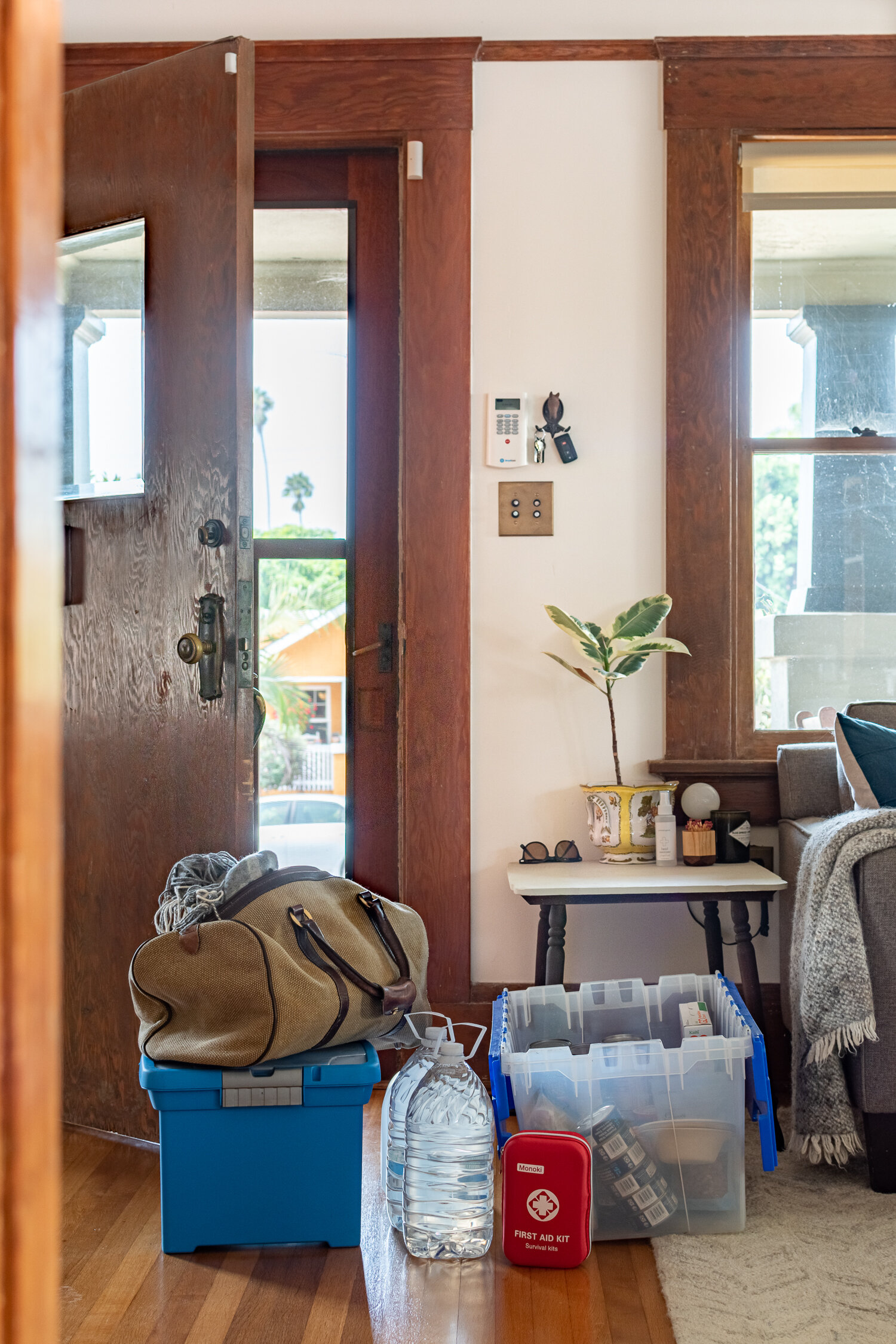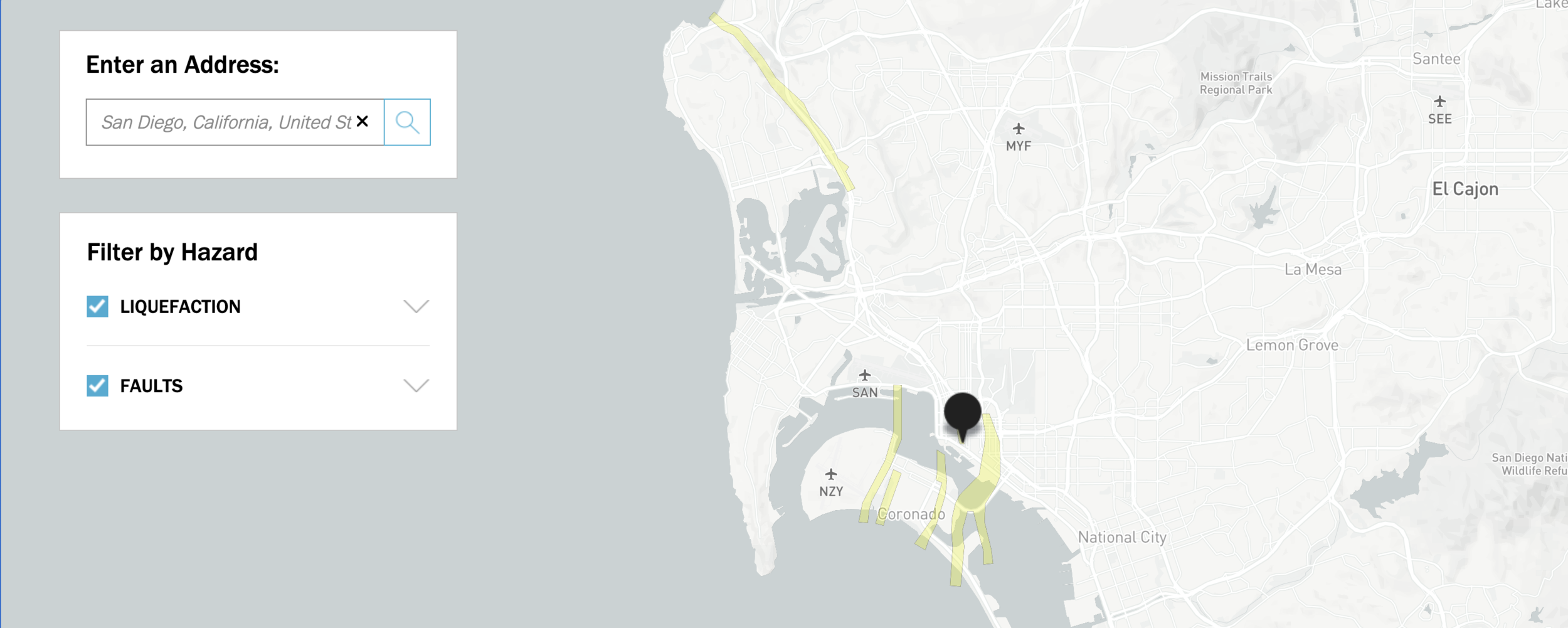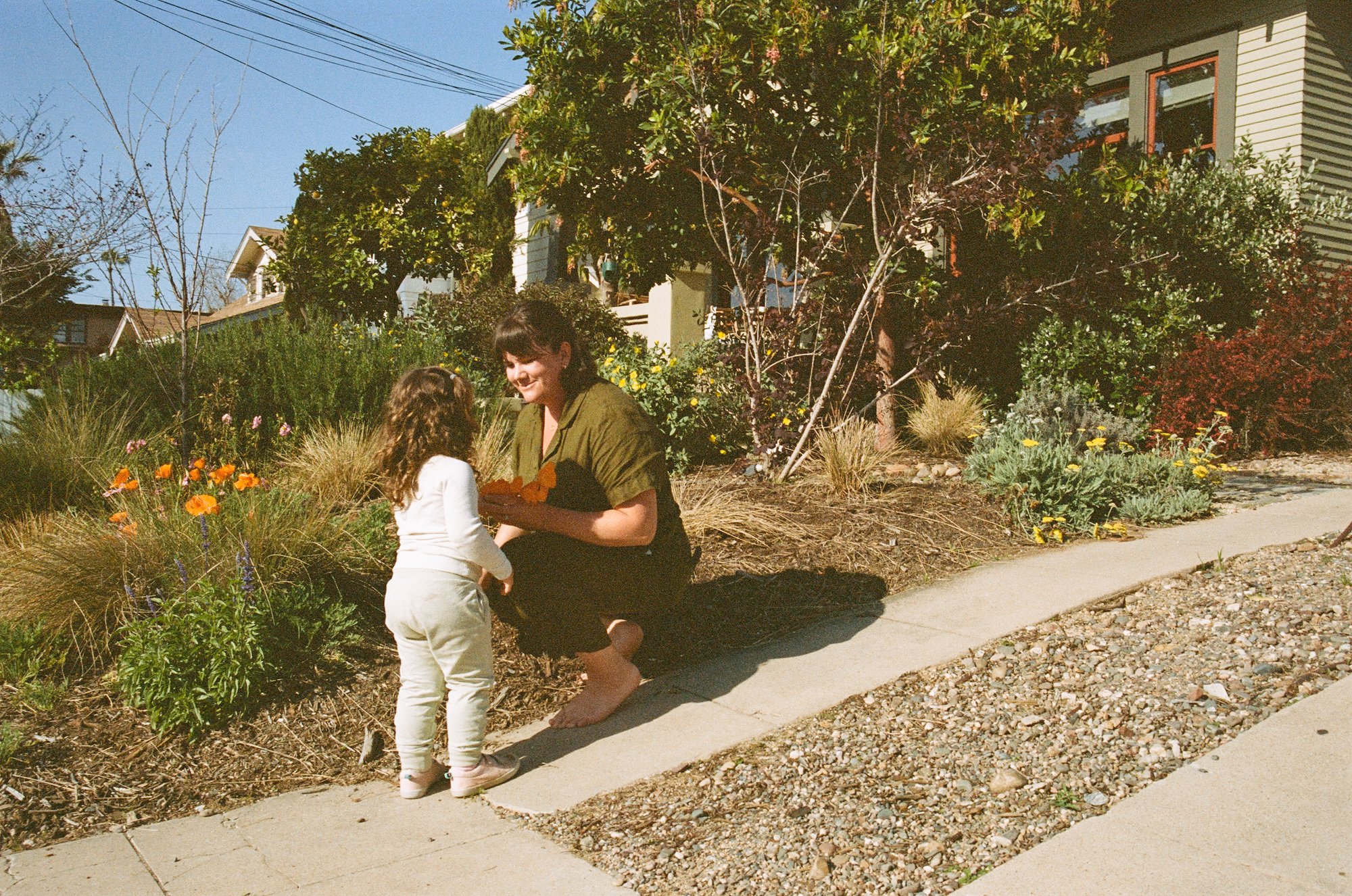Emergency Preparedness and Everything in My Evacuation Kit
/Emergencies that can displace us from our homes or leave us without our safety net can happen anywhere anytime. Being prepared for whatever comes is critical. I’ve got my evacuation go-bag set up by the front door during wildfire season, but it’s also important to have ready all year long. I’m sharing what’s in my kit and listing some resources for you to prepare for a variety of hazards, as well.
In San Diego, the hazards that loom over our heads are wildfires and earthquakes. These two issues have been a part of life since I can remember. We’ve lived through little earthquakes and know “the big one” is coming any time. We’ve evacuated from our homes for wildfires multiple times, and Ross lost his childhood home to a wildfire that tore through our suburban community in 2003. It can happen to anyone anywhere.
I want to say I’m not a serious “prepper.” Instead of letting a fear of disasters dictate how I live my daily life, I chose to be educated and prepared for the rare day. But I’ll also admit that I didn’t have my official emergency kit organized until this season. I’m ashamed to say I didn’t have a collection of items, but I do now and hope I can inspire you to do the same.
I’m not a hazard preparedness expert, and I won’t pretend to be. Instead of spelling everything out in this blog post, I’m going to direct you to resources that are much more comprehensive than I ever can be.
Resources
Ready.gov - This is THE resource for all things preparedness. Evacuation plans, caring for pets, supporting seniors, building a kit, financial preparedness, planning for hazards with kids, and being prepared at work. It has it all, and it’s worth taking time to read through the applicable resources.
Make a plan - A resource on Ready.gov, this one lists how to make a unique plan specific to your family, complete with downloadable PDFs to lay it all out. Don’t forget to set up alerts to be notified of happenings, too.
The Big One podcast - When The Big One hits it’ll take under two minutes for more than 10 million Southern Californians to lose internet, power, and a sense of security. This multi-episode podcast walks you through the admittedly horrifying experience of a big earthquake, how to survive it, and how to prepare for it. This series really shook me and taught me so so much - I highly recommend it!
Earthquake Education - Full of facts, figures, terrifying simulations, fault maps, and easy-to-digest tips, this is a good quick read.
How To Save A Planet podcast episode Unnatural Disasters - From hurricanes to wildfires, climate change is exposing more of us to extreme weather. This episode shares what it's like to survive a life-changing disaster and get tips on how to prepare from a disasterologist.
New York Times How To Pack an Emergency Kit For Any Disaster - This goes over all of the considerations for packing a kit and what to include.
Community Emergency Response Team - Find out what your local government and community organizations are doing to prepare and how you can get involved to support.
FIND LOCAL FAULT Lines ON THIS FAULT MAP
The Biggest Takeaway
Before I share what’s in my go-bag, I want to make clear the biggest takeaway for making a preparedness kit. The kit is only useful if you can use it. Keep it somewhere handy. Keep it stocked. Keep things that you’ll actually eat and use. Keep evacuation plans up to date and memorized. There are no rules and there’s no one-size fits all approach. Your kit must be customized to the things your family needs, and your action plans must be specific to your circumstances.
For example, I don’t live in a flood zone, so my kit doesn’t have waterproof matches and clothes packed in sealed bags. In fact, when I’m evacuating from a wildfire, lighting a match is the last thing I plan on doing. Also, Ross and I don’t have kids or pets, so our kit is pretty slim for just the two of us. We also packed food that we’ll actually eat! Don’t fill a big bin with food you wouldn’t otherwise eat.
What’s in My Emergency Kit
This is a collection of items that I’d use if we were hunkered in our home without power, but more importantly a bin of things we’d grab when evacuating. Depending on your hazard risk, you may prepare differently. No matter what, do what fits your needs best.
There are lots of marketed emergency kits that you can buy for a few hundred bucks. But the best thing to do is to buy the individual things that you will actually use. There’s no sense in buying the waterproof matches that I won’t use, nor should I buy the things I already own. Additionally, many of those kits lack really good quality multi-use items like a compact crank radio complete with a phone charger, a solar panel, an SOS flashlight, and NOAA weather scans and alerts. Plus, dehydrated astronaut food included in emergency kits has nothing on a can of Spaghetti-Os. I recommend making a kit custom for you, so what I’ll share below is just a guide, not a rulebook. But, I do hope my research for my kit helps alleviate some of the pressure for you to stock a kit!
I’m going to list lots of things in my kit with links to the products. You can open each window as I mention it, or click here for the entire shoppable list.
This compact crank radio complete with a phone charger, a solar panel, an SOS flashlight, and NOAA weather scans and alerts is definitely the workhorse of our emergency kit. For all of the things it offers, it comes in at a great price and is well-reviewed.
A good first aid kit is key. When evacuating after an earthquake, you may need to be pulling broken glass out of feet (tip, store shoes under your bed), or mending injuries. I bought this first aid kit because it had lots of extra gadgets (knife, whistle, scissors, can opener, multi-tool, etc.) Some other kits are mostly full of bandaids but I can buy those individually for a lot cheaper. Be sure to include Tylenol, antacids, and any medicine you may need for the disaster you’re planning for.
Water filtration is key! This LifeStraw is a great tool for filtering water without having to carry around gallons and gallons. At only $15 and with so many great reviews and testimonials, it’s a no brainer. This heavy-duty water tank is good for storing water which is an important fail-safe for the filter. Remember to have 1 gallon of drinking water per person (and animal) per day. I will also pack up my Berkey water filter, too.
There are different options for light and power, depending on needs. This solar lantern and phone charger is nice if you think you’ll be somewhere sunny (so not the greatest for wildfires or hurricanes) whereas this lantern has 60 days of runtime.
You’ll need to go somewhere when evacuating. A map of your region and a compass will serve well when our phones don’t have data or cell service. Note that the first aid kit I linked to has a compass, so don’t buy more than you need!
N95 masks are necessary in a wildfire but come in handy for other disasters, too. Hand sanitizer is also good to have on hand.
A whistle is good to have if you’re hunkered somewhere and need rescuers to find you. Note that there’s one in the first aid kit that I linked to, but it’s probably good for each family member to have one. Tip: save your breath yelling for help - use a whistle or find something to bang on consistently.
Trash bags can be used for so so many things - poncho, trash bag, suitcase, medical wrap, etc. This is no time to worry about single-use plastics, people.
In some disaster scenarios, it may be like camping or living in rubble and an apocalyptic feeling world. Or, it might be sitting in a gymnasium waiting for the hazard to pass before you can go home. When it isn’t life or death, it’s nice to be comfortable with toiletries, soap, toothpaste, etc. I included a link to a kit of toiletries, but I filled mine with travel soaps and toothpaste from the dentist. Shop your house before buying excess!
The first-aid kit that I linked to had lots of tools necessary in survival situations, but having some basic hand tools can help with turning off a leaky gas pipe, opening a hot water heater to drain water, or a variety of other tasks.
Be sure to back up your digital files on in the cloud and on external hard drives! You don’t want to lose valuable info and photos along with the other losses.
I packed my kit with food that doesn’t need to be cooked, but a hot meal is always nice. I have an induction cooktop leftover from when renovating the kitchen, so I’ve packed it in case wherever we evacuate to has electricity. Don’t forget to include a pot to cook with and a few utensils. And dish soap, too!
Be sure to pack a can opener and utensils for all of those canned beans you’re probably packing.
A friend of mine told me that in her evacuation kit she has comforts like coffee, tea, and treats to bring some joy during a tough time. I love the sentiment and packed some comfort food items for us.
Don’t forget about your pets! Pack their food, water dishes, toys, carriers, etc. so they’re comfortable. I’m going to actually pick up some pet food even though we don’t have animals just in case someone we run into needs it.
Food tip: Be sure to check the expiration dates on items. My mom always had a good habit of packing emergency food that would keep for a year, then annually she’d remove those items, cook with them, then re-stock more non-perishables for another year.
Other things in my kit:
Change of clothes
Blankets
Cash
Important documents (critical items are now all stored in one bin with a handle to grab easily)
Toilet paper
Bowls, utensils, and dish soap
A note to remind us to grab specific items from around the house such as:
Prescription medications and glasses
Passport and IDs
Phone, computer, chargers
Valuables
Heirlooms
Photo albums and artwork
Perishable food
My personal tips for packing a kit
Don’t forget morale boosters! Sure, you’ll want to eat foods that fuel your body, but don’t skimp on things that bring you joy and a sense of security (especially for kids). Pack in some marshmallows, tea, or other treats that give you a sense of comfort. Add in a coloring book, a favorite novel, puzzle, or other distractions and activites.
Shop your house for items to pack. We have a collection of plastic cutlery acquired from takeout meals that we’ll never use. So I put them in a used ziplock bag and tossed it in the kit! The small pot that I never use? It’s in the bin! The electric cooktop we used during the renovation? Now it’s in the kit. The old suitcase you don’t use? Now it’s your bin of spare food! The spare can opener I found in the back of the drawer? In the bin! As you upgrade household items, consider adding the old versions to the bin.
Ask your neighbors for any excess items to avoid buying things new.
Don’t rely on dehydrated foods because you don’t know how accessible water or cooking tools will be. Unless you’re evacuating on foot, you can fill up a bin with heavy hydrated foods as long as you can comfortably carry it to the car. If carrying weight is a challenge, pack things in a suitcase with wheels.
Get in the habit of storing important files digitally so you don’t need to rush to grab hard copies. We keep all of our computer files backed up in the cloud and on external hard drives. This includes photos, house plans, insurance information, out-of-state contacts, and all of our logins and passwords.
Make a Plan!
Having a packed go-bag or emergency kit is great! But, be sure to have a plan for your evacuation route, how you’ll communicate with family, and what you’ll do when you’re away from home. Ready.gov has lots of information about setting up systems and plans.
Here are some things you can do now:
Look into homeowners/renters insurance for different hazards
Film your home (even inside drawers) for insurance claims
Make a list of things you’d grab when you need to evacuate (food, clothes, photo albums, hard drives, whatever isn’t in your emergency bin)
Put important documents all in one place to grab easily
Set out a big bin to become your emergency kit. Instead of devoting a day to the process, just toss things in as you think of things to add throughout the week
Pressure your local, state, and federal officials to make it a priority to prepare for disasters and to make climate change a top priority. And vote for candidates that will make our planet safer
That’s all from me. I’ve merely skimmed the surface, so I urge you to read the resources I linked to and listen to the podcasts I recommended. This blog post is meant to hopefully inspire you to get a kit together and reduce the friction of doing the shopping and resource by giving you easy-to-shop links. Don’t forget all of the products I linked to are here in my Amazon Storefront.
If you have any favorite tips and suggestions, feel free to leave your ideas in the comments! Readers can gain insight from your experience.
Be safe, folks.

















































